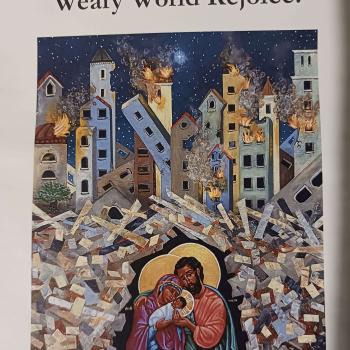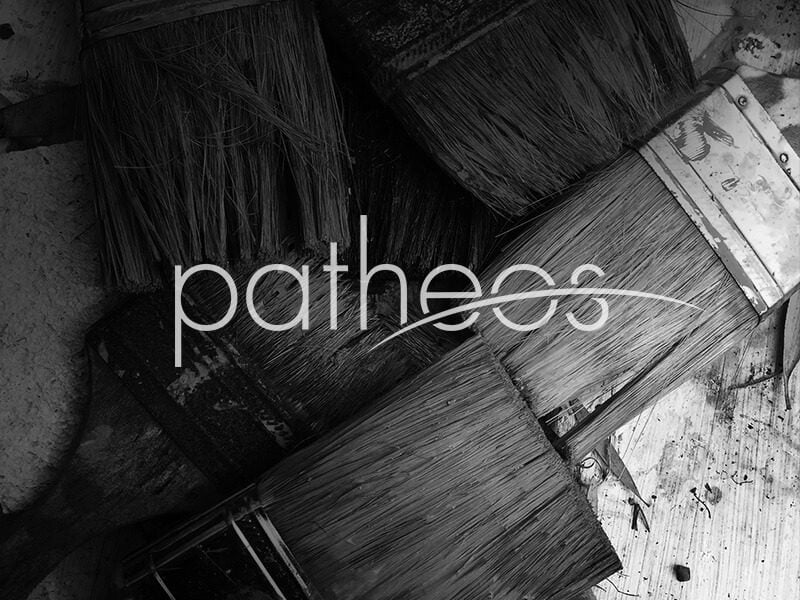From the Form which transcends all forms,
Love which transcends creaturely love,
Sophia in creation performs,
According to her prototype above.
She forms the great chain of being,
Reflecting all that is in divinity,
Actualizing what she has seen,
Into her own integral unity.
Uncreated Sophia is revealed to us as the tri-personal Godhead of Father, Son and Holy Spirit. That which God is, with all that God is, is this Uncreated Sophia. This Uncreated Sophia cannot subsist as an impersonal essence but is hypostasized in the three Trinitarian persons, because God is love and love is personal. All that God is is one in this Sophia. God’s wisdom is nothing other than God’s goodness which is nothing other than God’s love, and yet, Sophia is that which unites the three persons of the Trinity together: what they know themselves to be is that Sophia.
It is only out of the inner being of the Godhead, Sophia, that creation is made. It is made in the image of that being, taking what it is in it and merging it with differential levels of being, that creation forms within the space made for it within Sophia. “Unless we repudiate the very notion of Godhead, we cannot admit outside of God any existence in itself, real and positive. What is outside Godhead can therefore only be the Divine transposed or reversed.”[1] The absolute nature of God’s being allows nothing to exist outside of God’s authority, outside of God’s being. In this way, all that exists, exists in and through God, and finds itself as a reflection of God’s being. God is in this way, is the definition of being which defines all definitions, the form in which all created forms exists, and so, while God is transcendent to creation, creation cannot be said to be an absolute other to God.[2] If there were something outside of God, God would not be God, for God would be something less than absolute.
It is because God is absolute – absolute love – we can understand, in part, why God creates. God desires to allow others to participate in his being, and so creates a vast chain of being which allows for a diversity of subjects to participate in Sophia according to different levels of potentiality and actuality. God creates the space in which this range of potentiality is to exist – a space which accords room for even the lowest level of being, the emptiness of space,[3] so that the great chain of being can range from the Godhead all the way down to said emptiness. In creating the great chain of being, all that is in that chain, in its archetypal form, is good and beautiful, so that matter, even if it is next to nothingness on the chain of being, is a good and expresses something of the Godhead by coming out of and residing in Sophia.
While Uncreated Sophia is one and simple, we understand Sophia under a plurality of descriptions. “Though divine wisdom by reason of the diversity of things known and connoted goes under many names, yet it is not diversified in its intrinsic principle.”[4] As Sophia engages the space given for creation, the one simple Sophia is recognized in a plurality of images, and so a plurality of forms are established in creation. Yet, we must recognize the unity of those created forms, that they are an integrated whole, and it is as one within Sophia God knows and understands creation:
But because the perfection of wisdom is compatible with the height of simplicity, the first principle knows all things other than itself in itself and through itself. From this it follows secondarily that it knows created things uncreatedly, thirdly that it knows dependent things independently, fourthly that it knows temporal things eternally, fifthly that it knows future things presently, sixthly that it knows mutable things immutably, and seventhly that it knows contingent things infallibly.[5]
We can, however, through the light of Wisdom, come to see this unity, noetically realizing how Sophia remains undivided despite the logical distinctions we place within Sophia. This, of course, is what happens in theosis, when we have opened ourselves completely to God, purified from all sin:
Similarly our mind, illuminated by God’s ray, understands in that ray the rational principles of all things whose source is God and which themselves are God; and hence through God’s light it understands and knows only the divine light itself. Yet the mind seems to know different things, because it understands the light in terms of the different ideas and principles of things emanating from it. But although we know everything from day to day through God’s light and by degrees also perceive the light shining under this or that figure in objects, yet we will not see the pure light of God, independent of all ideas and utterly infinite at its source, until we attain the state of mental purity therein, when in a single glance, we gaze upon that very light refulgent in the splendor of all the ideas together. It is then, says the glorious messenger of truth, John the Evangelist, that we shall see God as He is, because we shall know God as God.[6]
All that is created is created out of God’s love, God’s Sophia, and continues to exist by that good love. Creation is united together by that love, even as God is united in love. This explains why creation, though fashioned into many objects, nonetheless is united together and must be seen as one:
For it belongs to the Good to conserve all that exists (and it is for no other reason that all things desire it); and if likewise that which conserves and holds together the being of each several thing is unity (since by unity each is maintained in being, but the dispersion displaced from existence): then the Good, wherever it is present, makes the participant one, and holds its being together in virtue of this unification.[7]
Creation is united as one, even as God is one, because creation is created good, and is made as a reflection of divine goodness. All that exists, in accordance to its existence, is thus good. And, by sharing in the goodness of creation, all creaturely being is united in one creaturely Sophia, even as the Godhead is united in Divine Sophia. All that exists, comes out of Divine Sophia, even if, in its creaturely being, it manifests its own freedom; creaturely being participates in the act of creation by how it takes the potentiality given to it and actualizes it by its will. Yet that potentiality is, nonetheless, given to it from Divine Wisdom. In this way, Ficino recognizes Divine Sophia as being the principle behind all of creation:
Where then is this wisdom? If it is in God on high, then God provides for things, since He reconciles mutual opposites do that they do not destroy one another and leads them all to the best possible ends. But if this wisdom were in any other thing below God, in angelic minds or in soul, it must still be acknowledged that God moves all below Himself. So if angelic mind or some soul rules the world and leads it toward the good, certainly it does so led by God and the power of God. God then is the first and highest ruler.[8]
Creation, created Sophia, created in and through Divine Sophia, will always remain in Divine Sophia, in the space Divine Sophia made for it. Created Sophia must come to know itself in its relationship with Divine Sophia, though in its freedom, created Sophia is capable of doing this according to its own will, a will given to it by God. Created Sophia is one, and thriving, as the beloved of Divine Sophia, as the created lover for Divine Love – and Divine Love, because it is love, cannot but give created Sophia created freedom, for to do anything but this would not be love. Created Sophia is thus known by many names by the ancients, one of which is that of the world soul:
This world-soul is a creature, the first of all creatures, the materia prima, the true substratum of our created world. In fact, since nothing can have any real and objective existence outside God, the world outside the Godhead can only be, as we have said, the divine world subjectively transposed and reversed: it is simply a false aspect or illusory representation of the divine totality. But even this illusory existence implies a subject putting itself in a false relationship and producing in itself the distorted image of truth. Since this subject can be neither God nor His essential Wisdom, a distinct subject or world-soul must be admitted as the principle of Creation properly so called. As a creature, it does not exist eternally in itself, but it exists from all eternity in God, in the state of pure potentiality, as the latent basis of the eternal Wisdom.[9]
Once we recognize its created nature, as the root of creation, we can overcome some of the errors they had of the world soul while recognizing the truth being represented by that idea. “That is, Sophia is all-integral creation and not merely all creation. Sophia is the Great Root by which creation goes into the intra-Trinitarian life and through which it receives Life Eternal from the One Source of Life. Sophia is the original nature of creation, God’s creative love, which is ‘shed abroad in our hearts by the Holy Spirit which is given unto us’ (Rom. 5:5).”[10] Or, as Bulgakov explains:
This content of the creaturely world, as well as its foundation, is the Divine world, the eternal Sophia. But the one, integral image of the All-unity in time is multiplied and atomized in the aspects of temporal being, which time gathers up and unites by its lawful regularity. Thus eternity is the depth, reality, foundation, and content of time. Time is correlative with eternity, does not exist without eternity; time is the image of the creaturely, becoming being of eternity. Time and eternity are the creaturely Sophia and the Divine Sophia. As a result, time is not empty; it is not the “vanity of vanities” of Ecclesiastes. Rather, time is full of eternity and asymptotically approaches it, more and more fully reproducing its image but without ever becoming identical to it modally, in mode of being.[11]
What unites creaturely Sophia, so that its plurality of contents can remain as one integrated reality while having their own reality is, as we have said, love, even as love unites the Divinity. And so it is love which we need to find if we want to attain our proper end with God:
What binds all things to order,
Governing earth and sea and sky,
Is love.
If love’s rein slackened
All things now held by mutual love
At once would fall to warring with each other
Striving to wreck that engine of the world
Which now they drive
In mutual trust with motion beautiful.
And love joins peoples to
By a sacred bond,
And ties the knot of holy matrimony
That binds chaste lovers,
Joins too with its law
All faithful comrades.
Oh happy race of men,
If the love that rules the stars
May also rule your hearts![12]
Creaturely Sophia, with its integral reality making it one, nonetheless follows Divine love and creates; it allows what is integrated in its participated oneness to have interdependent being. Creaturely Sophia acts in time, creating a field of existence for its contents in time and giving those contents their own freedom to manifest themselves in time. As Divine Sophia is the space in which Creaturely Sophia exists, so Creaturely Sophia becomes the space in which its subjects exist in plurality, with potentiality and actuality, that is freedom, of their own. Creaturely Sophia as world soul thus contains further derivations of Divine Sophia, each reflecting in their own microcosm the Divine Sophia through the mediation of the foundational Creaturely Sophia. In this way, humanity is also said to be Sophia, and each person is said to be Sophia, as long as we understand that by saying this, we are talking about derivative Sophia. Thus, we can talk about Divine Sophia, Creaturely Sophia, Humanly Sophia. This does not mean only humanity is to be seen as a derivative of Sophia. There can be other forms by which Creaturely Sophia can be seen reflected in creation, so that each animal species can also be seen as a reflection of the contents of Divine Sophia and so, derivative of Creaturely Sophia, of the world soul, each according to their level of potentiality. Pico della Mirandolla crudely put it this way:
Now the highest Father, God the master-builder, had, by the laws of his secret wisdom, fabricated this house, this world which we see, a very superb temple of divinity. He had adorned the super-celestial region with minds. He had animated the celestial globes with eternal souls; he had filled with a diverse throng of animals the cast-off and residual parts of the lower world.[13]
How all of this should be understood in the history of creation is where we shall turn to next.
[1] Vladimir Solovyov, Russia and the Universal Church, 161.
[2] For a thorough examination of this subject, see Nicholas of Cusa’s important work, De Ali Non Aliud (On God as Not-Other). For example, proposition 12 at the end of the text reads:
If anyone sees that Not-other is not only the definition of itself and of all things but also the object of its own definition and of the definition of all else, then in all the things which he sees, he sees only Not-other defining itself For what does he see in other except Not-other defining itself ?. What else [does he see] in the sky except Not-other defining itself? And similarly for all things. Therefore, the creature is the manifestation of the Creator defining Himself—or the manifestation of the Light (which is God) manifesting itself. This is comparable to a proclamation of a mind which defines itself—[a proclamation] which through living speech is made to those who are present and through a messenger or a writing is made to those who are distant. In these manifestations of the mind there is no other than the mind defining itself, manifesting itself vitally and most clearly to listeners through its speech, to those far away through a delegated speech, to those farthest away through a writing. In this manner, Notother, the Mind of mind, shows itself more clearly in the first creatures but more dimly in the others.
Jasper Hopkins, Nicholas of Cusa On God as Not-Other. A Translation and Appraisal of De Li Non Aiud. Third Edition (Minneapolis: The Arthur J. Banning Press, 1987; repr. 1999), 1163.
[3] There are different ways one could map out the great chain of being, and each are valuable in their own fashion. One way to do so, and which is being followed here, is to see the chain of being as being the chain of potentialities, from Absolute Being (God) being infinite potentiality simply united to perfect actualization of that potentiality in one perfect Act, down to non-being, which has no potentiality, and therefore, no actualization; non-being does not act. In between these two are many levels of potentiality and actuality; those with greater potentiality also have greater freedom in their act, greater ability to actualize that potentiality in a creative freedom (such as spiritual subjects), while matter, with its limited potentiality, hardly has freedom of its own, and is moved more from the acts of others than its own. Emptiness of space is not to be seen as non-being, because it a space of existence, but it is as close to non-being as possible.
[4] St Bonaventure, Breviloquium, 40.
[5] ibid., 40-1.
[6] Marsilio Ficino, Platonic Theology: Volume 4. trans. Michael J.B. Allen (Cambridge: Harvard University Press, 2004), 23.
[7] Proclus, Elements of Theology. Trans. E. R. Dodds (Oxford: Clarendon Paperbacks, 1963), 15 [prop 13].
[8] Marsilio Ficino, Platonic Theology: Volume 1. trans. Michael J.B. Allen and John Warden (Cambridge: Harvard University Press, 2001), 199.
[9] Vladimir Solovyov, Russia and the Universal Church, 162-3.
[10] Pavel Florensky, The Pillar and Ground of the Truth. trans. Boris Jakim (Princeton: Princeton University Press, 1997), 237.
[11] Sergius Bulgakov, The Lamb of God, 131-2.
[12] Boethius, The Consolation of Philosophy inBoethius: The Theological Tractates. Consolation of Philosophy. trans. H.F. Stewart, E.K. Ran, and S.T. Tester (Crambridge: Harvard University Press, 1990), 227.
[13] Pico della Mirandolla, On the Dignity of Man. trans. Charles Glenn Wallis, Paul J.W. Miller, and Douglas Carmichael (Indianapolis: Hackett, 1998), 4.












